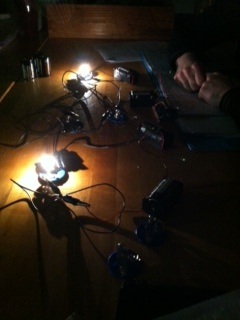Exploration of Electric Phenomena
One of the problems included in last night's homework was a question that one of the students asked at the end of last class: what would happen if you were to add a fourth bulb to the following circuit:

Each student shared the same prediction– they predicted that bulb #1 and #4 (added bulb) would be of equal brightness and brighter than bulb #2 and #3 which would also be of equal brightness of each other, but more dim than bulbs 1 and 4. Once the students came to an agreement, we decided to build the circuit! We discussed the “oomph” that a circuit needs to light the bulbs and the idea that you need more “oomph” to get more of the electric current through more obstacles. We had some challanges getting all four bulbs to light, but after adding a fourth battery… there was light! The students' predictions were correct.

The students had some trouble explaining exactly what an obstacle is in a circuit, but eventually understood that the amount or effect that an obstacle creates on the amount of “flow” getting through is determined by how the bulbs are attached, rather than how many bulbs are attached.
Emily also encouraged the students to think of the amount of “flow” or current getting through a circuit, rather than how fast it is moving through. As obstacles are added, more or less current is able to get through the wire, but how fast the current moves through the circuit stays the same.